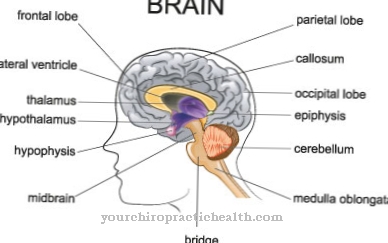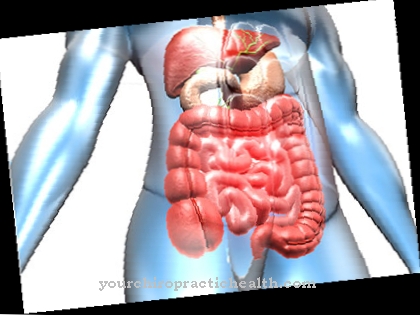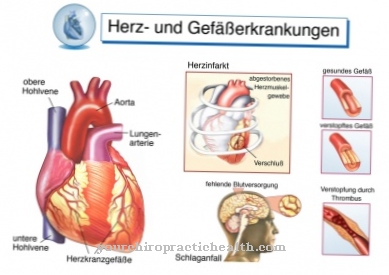A Aneurysm is a permanent enlargement of a carotid artery in the shape of a spindle or a sac. It can be congenital or acquired. This dilation of the arteries can occur with changes in the vessel wall at certain points in the vessels.
What is an aneurysm?

The Greek term aneurysm means “enlargement”. This is a congenital or acquired, localized, permanent, spindle-shaped or sac-shaped expansion of an artery as a result of a bulge or expansion of the vessel wall. There is a risk that the enlarged blood vessel will rupture and life-threatening internal bleeding will occur.
Aneurysm is more common in older people. Risk factors for this are high blood pressure and hardening of the arteries (arteriosclerosis). If an aneurysm ruptures, only life-saving surgery will help. A widespread aneurysm close to the heart or in the brain is life-threatening because the increased pressure on the vessel wall threatens to tear and result in internal bleeding. In this case, life-saving surgery is essential.
Classification:
- real aneurysm - all three wall layers of the artery bulged out
- Split aneurysm - bleeding into the vessel walls splits the vessel walls and injures the middle vascular layer
- fake aneurysm - the bulge is caused by damage to the vascular wall, for example during catheter interventions for the diagnosis and treatment of heart disease.
causes
Aneurysm can have several causes. The most common cause of a true aneurysm is hardening of the arteries. Infections are much less common.
For example, syphilis can cause the arteries to widen in the main artery (aorta), through which blood flows from the heart to the body. Other infections tend to affect arteries distant from the heart.
A heart attack or parasite-induced Chagas disease can cause an aneurysm to form in the wall of the heart. A fake aneurysm is a possible consequence of catheter surgery. In a split aneurysm, the middle vascular layer, the media, of the artery is injured.
Symptoms, ailments & signs
Many people have an aneurysm and never experience it in their lives. You have no symptoms and the aneurysm does not lead to any disease or secondary disease. The number of unreported cases cannot be recorded statistically.
But it is more likely that aneurysm will cause symptoms sooner or later. This usually happens when it grows. That means the bulge it forms is expanding and getting bigger. It then presses on other parts of the brain and causes complaints and disorders here. These depend on the location of the aneurysm.
For example, the language center can be affected - the patient then increasingly suffers from language and word finding disorders. He forgets words and concepts and finds it difficult to formulate entire correct sentences. Often the sentence is broken off halfway through without the patient realizing it himself.
If the aneurysm presses on the visual center, for example, impairment of vision can be expected. This can affect both visual acuity and the field of vision itself. Eye flicker and loss of three-dimensional vision are common signs of an aneurysm.
If the sense of balance is impaired, it is difficult for the patient to control his walk and his body. Trips and falls are the result. All of these signs point to neurological deficits and abnormalities.
course
Symptoms of the disease of an aneurysm only appear when the blood vessels in a particular artery expand. For example, an aneurysm in the main artery in the chest area can cause difficulty swallowing, coughing, hoarseness, breathing difficulties and circulatory disorders in the arms or brain.
Symptoms of an abdominal aorta aneurysm include back pain, pain radiating to the legs, urination, and alternating diarrhea or constipation. The aneurysm is rarely noticeable through a throbbing "bump" in the abdomen. If the wall of a split aortic aneurysm tears, a sudden, devastating pain occurs.
In this case, the emergency doctor must act immediately. If arteries distant from the heart are enlarged, there is a risk of blood clots forming, which can then migrate to the heart or lungs and trigger an embolism. An aneurysm in the brain can have serious consequences because it can press on cranial nerves and cause failure.
Complications
Aneurysm can form in various parts of the body and, depending on its location, cause serious complications. If the blood clot is not recognized and treated in time, the blood flow to vital organs and limbs is no longer guaranteed. There is a risk of congestion, embolism and stroke.
If a supplying or branching area closes or if the vessel wall of the aneurysm bursts, for example on the head or near the heart area, the person concerned is in mortal danger. The help measures that are immediately initiated cannot rule out permanent damage such as paralysis or irreparable functioning of the brain.
The risk group for the formation of a blood clot is diverse. Older and young people are equally affected, as are accident victims. Alternative methods cannot clear a blood clot. The doctor alone decides on the type of operation and therapy. During surgery, there may be more blood loss.
If the clot is removed from the head, it may be necessary to avoid cerebral hemorrhage with cerebral ventricular drainage. If the symptom is detected and removed in time, further measures must be taken to avoid inflammation, cardiovascular problems and the penetration of bacteria into the wound. Depending on the severity of the procedure, swallowing difficulties and shortness of breath may occur. Patients can counteract complications by following subsequent medication and a healthy lifestyle.
When should you go to the doctor?
If an aneurysm is suspected, medical advice should be sought immediately. A quick visit to the doctor is recommended if chest pain, coughing or abnormal breathing noises occur that occur suddenly and cannot be attributed to any other cause. Sudden hoarseness, swallowing disorders or shortness of breath are warning signs that should be clarified as soon as possible. If there is severe abdominal pain or bleeding, the aneurysm may already have ruptured - at the latest then an ambulance service must be called.
If there is a sudden drop in blood pressure or a circulatory shock, first aid must be provided until the emergency doctor arrives. A visit to the doctor is almost always necessary with an aneurysm. If the vasodilatation has already been diagnosed by a doctor, attention must be paid to the typical warning signs.
If it is suspected that the aneurysm has ruptured, all that remains is to go to the emergency room. In general, you should speak to a doctor if you have unexplained numbness and coldness in the limbs or other symptoms that cannot be traced back to a specific cause. Prompt treatment can usually prevent further complications.
Doctors & therapists in your area
Treatment & Therapy
For an aortic aneurysm: If the aneurysm is not that large or the risk of surgery is too high, the doctor can treat risk factors such as high blood pressure with medication (beta blockers) and encourage the patient to avoid physical exertion and to ensure regular digestion.
If you have a larger aneurysm or high blood pressure that cannot be controlled, an operation cannot be avoided.Here, the enlarged part of the vessel is replaced by a plastic prosthesis. Newer methods also enable a smaller (minimally invasive) procedure in which the surgeon uses a catheter] to insert a stabilizing stent prosthesis, a kind of umbrella, into an artery, which can then be opened in the vessel.
For a brain aneurysm: the neurosurgeons take care of an aneurysm in the brain. In the past, they clamped the aneurysm with a clip during open surgery or reinforced the vessel wall with tissue or Teflon. Today you can also intervene in the vessels in the brain via the inguinal artery and stabilize the vessels in such a way that the risk of rupture is averted.
Outlook & forecast
As a rule, an aneurysm has a very negative effect on the patient's quality of life and, in the worst case, can even lead to the death of the person affected.
Aneurysm is primarily diarrhea or constipation and the urge to urinate is also the main problem. In most cases, these complaints do not go away on their own, so that self-healing does not occur. It is not uncommon for the aneurysm to lead to coughing and shortness of breath, which can lead to a loss of consciousness. Difficulty swallowing can also occur, which significantly reduces or complicates the intake of liquids and food.
Whether the aneurysm is treated usually depends on the severity of the disease. In some cases, the risk of surgery is too high, so treatment is carried out solely with the help of medication. This can limit the symptoms. However, it cannot be ruled out that the patient's life expectancy may be reduced by the disease.
Furthermore, surgical intervention cannot be avoided in severe cases. It cannot be universally predicted whether this will lead to complications. In some cases, the affected person is dependent on a catheter after the operation.
prevention
Preventing an aneurysm is only possible to a limited extent. It is important to avoid or treat risk factors such as high blood pressure, smoking, alcohol, obesity and excessively high blood lipid levels as far as possible. Living healthy, eating sensibly, and getting enough exercise is definitely a sensible approach to preventing aneurysm from developing.
Aftercare
After treatment of an aneurysm, regular follow-up care by a neurosurgeon or neurologist is required in the first few months. So-called echocardiography is often performed at the check-up appointments, with which the function of the aortic valve can be checked. At the beginning, these examinations usually take place once a week, then only once a year.
Many patients also have to take medication such as rhythm stabilizers or painkillers after the operation, and rehabilitation is often carried out after the hospital stay, which usually lasts seven to nine days. In addition, those affected should eliminate risk factors if possible.
Nicotine should be avoided completely, as it can narrow the blood vessels and make the clip unstable. Furthermore, the blood pressure should also be adjusted very well. Here, too, regular checks and, if necessary, treatment of blood pressure with medication are necessary.
If patients suffer from diabetes mellitus, the attending physician must also adjust them carefully, since diabetes that is not optimally adjusted could have negative effects on the blood vessels. In general, a healthy lifestyle should be adhered to, that is, those affected should exercise regularly, avoid nicotine and pay attention to a healthy diet.
You can do that yourself
Patients with aneurysms have regular check-ups with a specialist in order to monitor the condition of the deformity and to react in good time to critical innovations. Even outside of medical care, patients pay close attention to their physical condition and register potential changes in the aneurysm.
Since an emergency is possible at any time for patients with aneurysms, the people around them must be informed about the disease and possible first aid measures. In the case of an aneurysm, a medical emergency usually manifests itself in a collapse of the circulatory system, with the blood pressure falling rapidly at the same time.
Many patients with aneurysms receive medicinal agents for therapy and prevention of complications, which must be taken according to the doctor's prescription. In addition, a healthy lifestyle tailored to the disease can help prevent or minimize complications and possible exacerbations of the disease.
A significant risk factor for an existing aneurysm is, for example, high blood pressure. To help themselves, patients reduce their excess weight and also adjust their diet to the symptom. If you have an existing aneurysm, it is also beneficial to refrain from smoking. The consumption of alcohol should also be greatly reduced and, if possible, stopped completely.
























.jpg)



